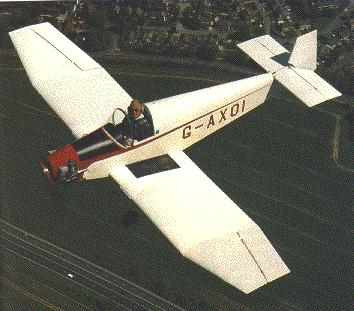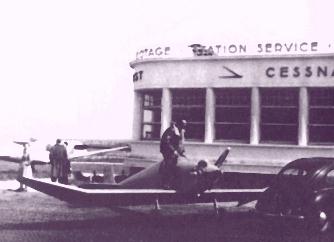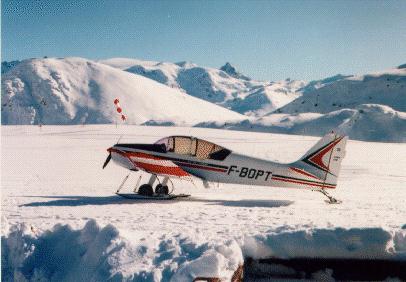|

Robin aircraft history, performance and specifications
|
 |


The
beginning
The
Jodel design can be traced back
to the end of the second world
war when the French government,
recognising the value of light
aviation, purchased considerable
numbers of Tiger Moths and Miles
Magisters at a very low cost.
These were then passed on to
flying clubs.

D9 Bebe
But these ex-wartime
trainers were very fuel
hungry and slow. This left
a gap in the market for
Edouard Joly, a private
pilot who lived in the
area of Beaune, and his
son-in-law Jean Delemontez,
to fill. The story goes
that they fell upon some
pre-war aircraft-quality
plywood and an old 26 hp
Poinsard engine and
without formal training in
aerodynamics decided to
design their own
single-seat light
aeroplane. The wood was
turned into a small,
single-seat aircraft with
cranked wings. It was so
tiny, particularly
compared to existing
training aircraft, that
they called it the D9 Bebe
(Baby). The fact that
Delemontez spent so much
time working on the
aircraft, rather than with
his wife (Joly's
daughter), is also
reported to have something
to do with the naming.

The
prototype D9 at its first
flight
Edouard Joly being the pilot
at this
very grey winter day with
snow on the runways
Now, that's how the story
went, and it's certainly
the stuff that legends are
made of. But the truth is
rather different. Jean
Delemontez was en
experienced and trained
aeronautical engineer and
Eduard Joly also had many
years experience of
aircraft construction,
having built a Pou du Ciel
(Henri Mignet's flying
flea) before the war. The
two men were operating a
major aircraft and glider
maintenance and repair
establishment before the
Jodel series' design and
build efforts commenced.
So the implication that
the material for the first
D9 were 'found' at the
back of a hangar is
clearly fabrication, but
fun nevertheless.
Initially, the D9 was never
intended for any other use than
their own pleasure flying. The
performance of the little single
seater was so promising however,
that lots of people, including
the government, were standing in
line to purchase one.
Reluctantly, the two men gave in
and started producing them and
selling building licences. Over
500 D9's were constructed in the
20 years to follow.
The
design progress
The
structural and aerodynamic
features of the D9 and
subsequent designs are quite
sophisticated, as shown by the
robustness and performance of
the aircraft, and serve to
underline Jean Delemontez's
professional abilities.
Then, as now, the French
government, always keen to
encourage local enterprise,
showed an interest in the design
and a slightly larger aircraft,
the D11 with two seats,
followed. Joly and Delemontez
formally set up a company,
combining their names. The Jodel
company was born.

The
first two seater: The D11
series
The two seat D11 series
was therefore designed and
constructed as a prototype
batch for a French
government requirement for
an aero club trainer. The
D11 was successful and its
variants, principally the
65 hp D112, the 90 hp D117
produced by Society
Aeronautic Normande (SAN)
at Bernay and the 90 hp
D120 from Avions Wassmer
at Issoire, were produced
in large numbers for
aeroclubs through the
French government subsidy
scheme. I have also seen
versions that were called
D119 and 1190.
The Jodel company did not really
manufacture that many aircraft
itself, their idea being to
licence other firms. Jean
Delemontez worked directly with
two organisations in particular
to develop the various Jodel
models and series. With SAN at
Bernay he developed the 180 hp
four to five seat D140
Mousquetaire and later the 100
hp two seat D150 Mascaret. New
samples of the breed are still
being developed, the D18 and D19
being the most recent models.
From the 1950s onwards various
types, D11, D112, D117 and so
on, were built by various
companies. There was also a
large pool of amateur builders
whose examples were generally
powered by 90 hp Continental
C90s or 100 hp O-200s and
usually designated D111. Roughly
1500 commercially built aircraft
of this series were produced.
The
Robin connection
Jean Delemontez's work with
Pierre Robin's Centre Est
Aeronautique (CEA), later
renamed
Avions Robins, is well
known. The CEA Jodel Robin was
based on Jean Delemontez's
earlier D10 concept, a four
seater whose wing had been
constructed but then shelved
when the D11 work became more
urgent. Together with Pierre
Robin Jean Delemontez took the
Jodel Robin through the DR100,
200 and nosewheel DR300/400
series between 1957 and 1972.
The
progression of the DR series
was:
- DR100 -
First produces with 90 hp
Continental C90
- DR105 - As
for the DR 100, but with
hydraulic brakes
- DR1050 -
As for the DR 105, but with
100 hp Rolls Royce or
Continental O-200 engine.
- DR1051 -
As for the DR 1050, but with
105 hp Potez 4E20 engine.

DR 1051
M with late model tailplanes,
a member of the DR 100
family
Later versions of the DR
1050 and 1051 had a
revised tailplane design,
giving the model a greater
Centre of Gravity range.
These models were
designated DR 1050 M and
DR 1051 M and carried the
names Excellence for SAN
built models and Sicile
Record for those
constructed by CEA. This
name originated from the
1964 Round Sicile Rally,
which was won by Pierre
Robin at an average speed
of 162 mph (in a 105 hp 4
seater!)
The
DR 100 series was succeeded by
the Robin DR 200 range of
aircraft, being very similar to
the DR 100's. The DR 200 series
started with the DR 220, of
which 83 were built in 1967. The
220 was eventually given a 108
hp Continental O-235 engine, in
stead of the original O-200A,
and was then called the DR 221
Dauphine. The Dauphine was later
given a 160 hp Lycoming
O-320-D2A engine, making it the
DR 250 Capitaine. The DR 250 was
the ultimate taildragger. After
some 100 of them were produced,
the DR 250 was later given a
larger fuselage, trigear
undercarriage and a 180 hp
Lycoming O-360-D2A, making it
the DR 253 Regent.
By this time, the whole range of
aircraft had been taken over by
Robin. Meanwhile, Joly and
Delemontez were not sitting
idle. Having built the D9, D10
series (=DR100) and D11 series,
it was time to move on. After
some ideas that never
materialised, the D140
Mousquetaire was introduced. It
was to become the biggest Jodel
ever built: a 180 hp tailwheel
design with four/five seat
capacity. Early Mousquetaires
featured a rather ugly triangle
vertical tailplane, later ones
were fitted with tailplanes like
on the DR 1050 M and DR 200
series.

D140
Mousquetaire, the largest Jodel
production model
The
next design coming from
Delemontez' drawing board was
the D150 Mascaret. The Mascaret
was intended to be the successor
of the aging D11 series. It was
a two seater, fitted with a
modified DR100 wing and a 100 hp
Continental O-200A engine. The
design proved very successful
and quite a few have been built
by both factory and amateur
builders.
After the D150, a D160 prototype
was built. It was to become a
six seater fitted with a six
cylinder 235 hp Lycoming engine.
The interior was fitted with two
sets of individual seats and a
rear bench seat. It had an
electrically actuated canopy,
hinged on the port side. It
featured a wing span of 10,86
meters and had a length of 8,32
meters. A version with
retractable gear and a constant
speed prop was envisioned, but
ultimately, the D160 never saw
production.

Homebuilt D18
As far as is known, the D
17, never saw the light of
day. The D 18 and D 19,
however, do exist. They
are small two seater homebuilts that are
usually powered by
converted Volkswagen
engines. Plans are being
sold to homebuilders, but
they were never factory
produced. Just recently,
the D 20 prototype was
unveiled. It is a trigear
scaled down Robin DR 400
look-alike. SAN plans on
producing it in kit form
for amateur builders.
The
original Avions Jodel company
still operates as a design
bureau and licences constructors
(professional and amateur)
through the sale of plans for
specific models, D9, D11 series,
DR100 series, D140, D150 and
more recent D18 and D19. In
addition an associated company
SAB (Society Aeronautique
Bourgoyne) produces parts (fuel
tanks, canopies, undercarriages)
for most Jodel variants.

Modern,
tricicle DR 400
In October 2004 Alpha Aviation
Ltd based in Hamilton New
Zealand exercised an option to
purchase from Robin Aviation all
the Jigs, Tooling and
intellectual rights to a series
of aircraft known as the Robin
R2000 series. These aircraft are
two seat all metal trainers and
include a fully FAA certified
aerobatic variant known as the
Robin R2160. Production is
scheduled to commence in August
of this year with delivery of
the first aircraft scheduled to
follow before the end of
December.
Avions Robin, now Apex,
still own and will continue to
produce all their other types
consisting primarily of the
DR400 series.
|
